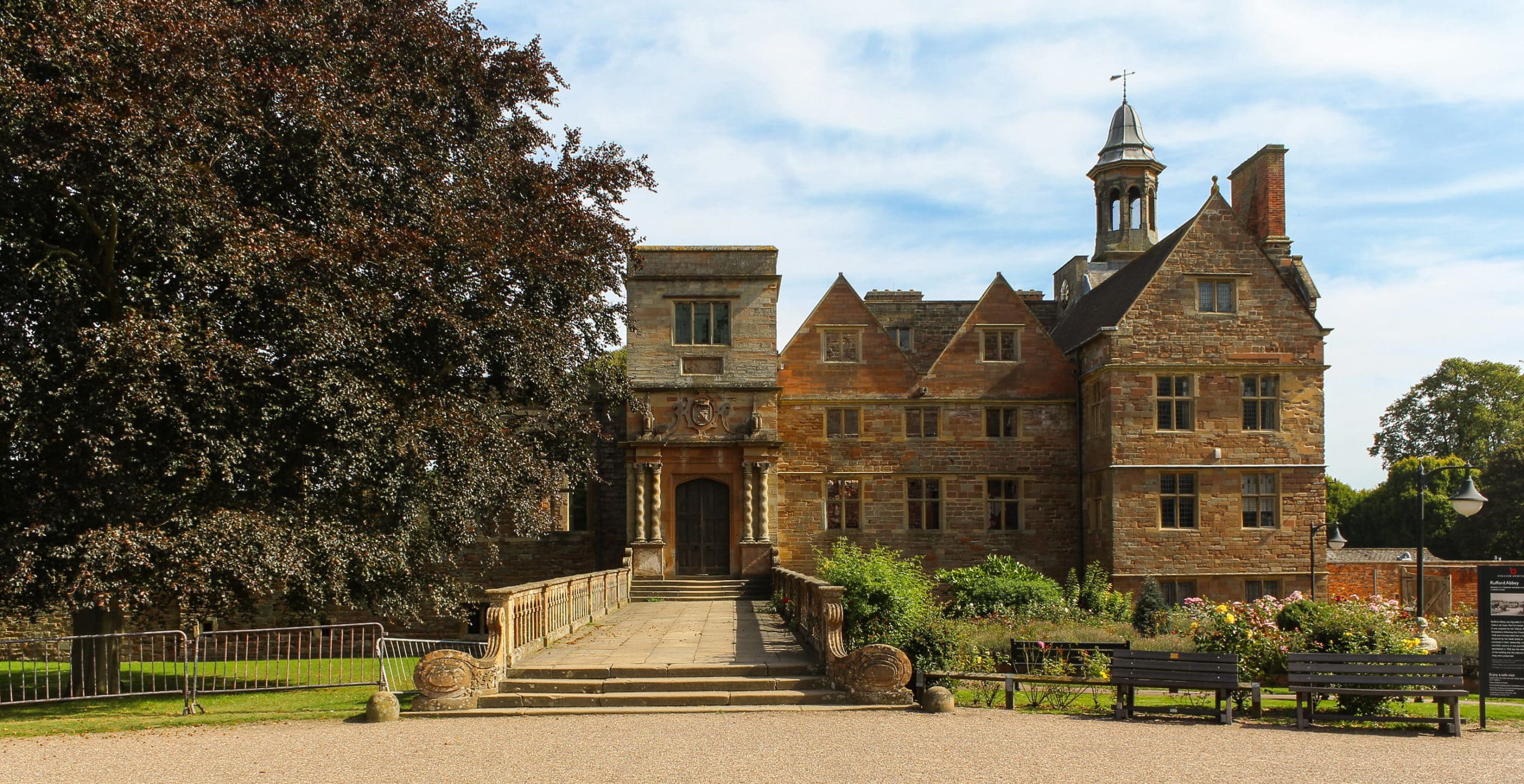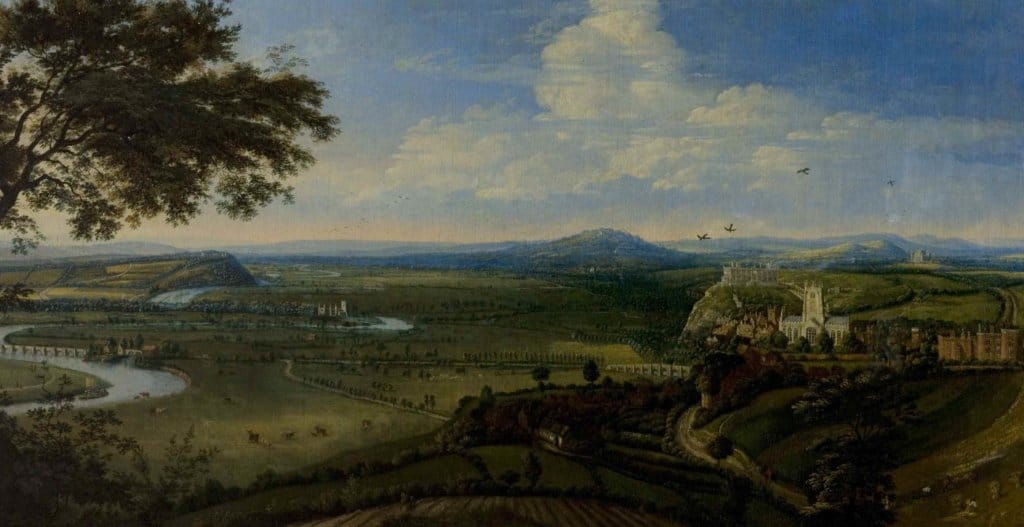Surrounded by 150 acres of glorious parkland, Rufford Abbey is a great historical landmark nested in the Nottinghamshire countrysde.
Beginning its life as a Cistercian Abbey, it was greatly affected by the reign of King Henry VIII and the subsequent Dissolution of the Monasteries. Like many other abbeys during this time, the building itself was to be later reinvented, becoming a grand country estate in the 16th century.
Sadly, more recently, part of the building was demolished, leaving behind only remains of this once great historic abbey.
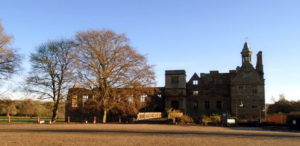
Today, it is open to the general public as Rufford Country Park, a beautiful and picturesque estate with miles of woodland walks, attractive gardens and ample wildlife to enjoy and observe.
With plenty to explore including the splendid man-made lake which is now home to a wonderful array of bird species and other wildlife, the gardens of Rufford Abbey are a perfect place to relax, walk and appreciate the landscape.
The former abbey and country estate is a Grade I listed building, having been founded in 1146 by Gilbert de Gant, Earl of Lincoln. It was destined to become a Cistercian abbey with monks from Rievaulx Abbey.
The Cistercian order was typically austere; beginning in Citeaux in France, the order grew and spread across the continent. In 1146 around twelve monks from Rievaulx Abbey, one of England’s best known Cistercian monasteries, relocated to Nottinghamshire under the leadership of the abbot Gamellus.
The changes they made included creating a church on this newly acquired land as well as creating infrastructure necessary to maintain a good water supply for their own needs as well as for the lucrative wool industry.
At this time in medieval England, abbeys were extremely vital institutions which became centres not only for religious life but also political and economic structures. Monks served in political roles as well as forming an important part of the wool trade in the north of England. An abbey was a lifeline of infrastructure in the local community as well as being the epicentre of activity.
Sadly, with such power wielded by the monks, so too were high levels of corruption and mismanagement of funds. The religious institutions of medieval England were thus strongholds of greed and lavish lifestyles in stark contrast to the spiritual life intended by the origins of such a community.
In 1156, the English Pope Adrian IV gave his blessing to the abbey, leading to its considerable expansion into neighbouring villages. Sadly for the local people, this meant evictions in areas including Cratley, Grimston, Rufford and Inkersall.
The development of a new village called Wellow was a construction designed to provide accommodation for some of those affected. Nevertheless, conflict did arise between the abbot and the local people who frequently clashed over the rights of land, particularly the acquisition of wood from the forest.
Meanwhile, the construction of the abbey was well underway and would continue to be built and expanded for decades to come.
Sadly, like many of the abbeys in the British Isles, Rufford was to experience a sad fate when Henry VIII instigated the Dissolution of the Monasteries, an act which began in 1536 and concluded in 1541. As part of this process, monasteries as well as convents, priories and friaries across Britain were disbanded and had their assets and incomes appropriated.
The policy saw King Henry VIII break away from the Church of Rome and reclaim the assets of the Catholic Church, boosting the coffers of the Crown. Henry VIII was now the Supreme Head of the Church of England, delineating a distinct division from any papal authority previously enacted over the churches.
For Rufford, the wrath of Henry VIII’s new found authority was to be enacted against the abbey when he sent two investigating commissioners to find justification for permanently closing the abbey.
With such great value accrued by the monks, Rufford was an important asset. Therefore the two officers claimed to have discovered a range of deplorable sins at the abbey. One of these included the accusation that the Abbot, Thomas of Doncaster was in fact married and had broken his vow of chastity with numerous women.
The Cistercian Abbey’s days were numbered and in the following years the Royal Commission closed Rufford Abbey once and for all.
It was after this sad series of events for the abbey that rumours of a ghost, a monk carrying a skull and lurking in the shadows of the abbey, began to circulate.
Nevertheless, a new era was dawning and like many other religious institutions across the country, the abbey found itself transformed into an estate, a great country home, by its new owner, the 4th Earl of Shrewsbury. Converted into a country house and transformed by subsequent generations of the Talbot family, by 1626 the estate had been passed on to Mary Talbot, the sister of the 7th and 8th Earls.
Through the marriage of Mary Talbot, the Rufford country estate passed on to her husband, Sir George Savile, 2nd Baronet and remained in the Savile family for several centuries. Over time the home was expanded and altered by subsequent generations of the family. Some of the improvements included the addition of five ice houses, a precursor to the refrigerator, as well as a bath house, the construction of a large and impressive lake, a coach house, mill and water tower. Today only two of the original ice houses remain.
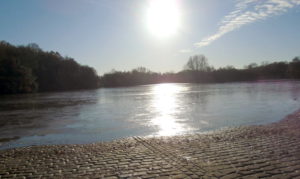
Under the ownership of the Savile family, the estate grew to become a great hunting lodge, typical of the country homes of the day. In 1851 however a dramatic encounter occurred between the estate gamekeepers and a gang of forty poachers who were protesting against the monopolisation of hunting by the wealthy elite in the area.
The incident quickly escalated and a battle ensued between the protesting poachers and ten of the estates gamekeepers resulting in one of the gamekeepers dying of a fractured skull. The culprits were subsequently arrested and sentenced to manslaughter and deportation. In popular culture, the incident became the source of a popular ballard called the Rufford Park Poachers.
In the centuries that passed, the running of the estate quickly became an uphill struggle and in 1938 the estates trustees decided to sell, with some of the land going to Sir Albert Ball, whilst the home was in the possession of Harry Clifton, a well-known aristocrat.
As the prospect of war loomed ominously over the continent, the estate passed through several hands over the following decade. It was used as cavalry offices and also housed Italian prisoners of war.
Sadly by the 1950’s, through war and neglect the country estate was in a sorry state. Since the late 1950’s, the country estate has once again reinvented itself as a splendid country park with a great wealth of wildlife, beautiful structured gardens and a peaceful and tranquil lake.
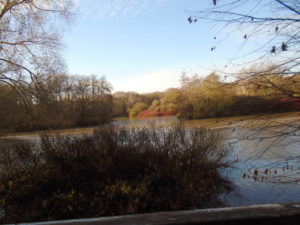
Rufford Abbey has had a turbulent history. Today, the remains of the medieval monastery are framed beautifully by the splendid Nottinghamshire landscape.
Jessica Brain is a freelance writer specialising in history. Based in Kent and a lover of all things historical.
Published: 19th February 2020.
